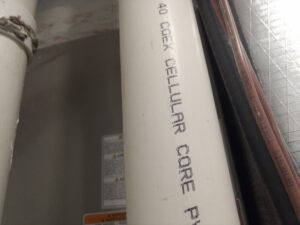When it comes to venting systems for heating appliances, the choice of materials is critical for safety and efficiency. One material that has raised significant concerns in recent years is “cellular core” piping, commonly used in exhaust systems for high-efficiency furnaces, boilers, and water heaters. Understanding the potential dangers associated with this type of piping is essential for homeowners and contractors alike.
What is “Cellular Core” Piping?
“Cellular core” piping, typically made of PVC or ABS, features a hollow core that makes it lighter and cheaper than solid core alternatives. While the initial cost savings might be appealing, the implications for long-term safety and functionality are concerning.
Why is “Cellular Core” Piping Problematic?
- Heat Sensitivity: “Cellular core” piping is not designed to withstand the higher temperatures produced by exhaust gases from modern heating systems. Prolonged exposure to these temperatures can cause the inner structure of the pipe to warp or crack. This degradation can lead to holes in the piping, allowing toxic gases, such as carbon monoxide, to escape into living spaces.
- Safety Risks: Cracks and holes in exhaust pipes pose serious health risks. Carbon monoxide is a colorless, odorless gas that can be lethal. Instances of carbon monoxide poisoning due to faulty “cellular core” piping have been documented, prompting municipalities to reconsider its use in residential applications.
- Regulatory Changes: Many cities and building codes have begun to prohibit the use of “cellular core” PVC and ABS for venting applications. For example, Loveland, Colorado, has enacted policies specifically banning this type of piping for exhaust systems due to safety concerns highlighted by rigorous testing and incidents of failure. Other states, such as California, New York, and Massachusetts, have also introduced regulations limiting or banning the use of “cellular core” piping in HVAC systems.
Recommendations for Homeowners
If you suspect your home may have “cellular core” piping installed for venting, here are steps you can take:
- Inspection: Regularly inspect the exhaust pipes near your heating appliances. Look for any labels that indicate “cellular core.” If identified, consult a qualified HVAC contractor to evaluate the condition of your piping.
- Upgrade: Consider replacing “cellular core” piping with solid core alternatives that meet safety standards. Solid core PVC and ABS are more robust and designed to handle the exhaust temperatures generated by heating systems.
- Carbon Monoxide Detectors: Install carbon monoxide detectors in areas where heating equipment is located. This can provide an early warning of any potential leaks.
- Stay Informed: Be proactive about understanding local building codes and regulations regarding piping materials. Keeping abreast of changes can help you make informed decisions about your home’s safety.
Conclusion
While “cellular core” piping may offer initial cost savings, the potential dangers it poses make it a poor choice for venting exhaust gases from heating appliances. Homeowners should be vigilant about the materials used in their home systems and prioritize safety by opting for more reliable alternatives. Regular inspections and adherence to local regulations can help ensure a safe living environment. If you’re unsure about your installation, consult with a professional to assess and address any risks.









